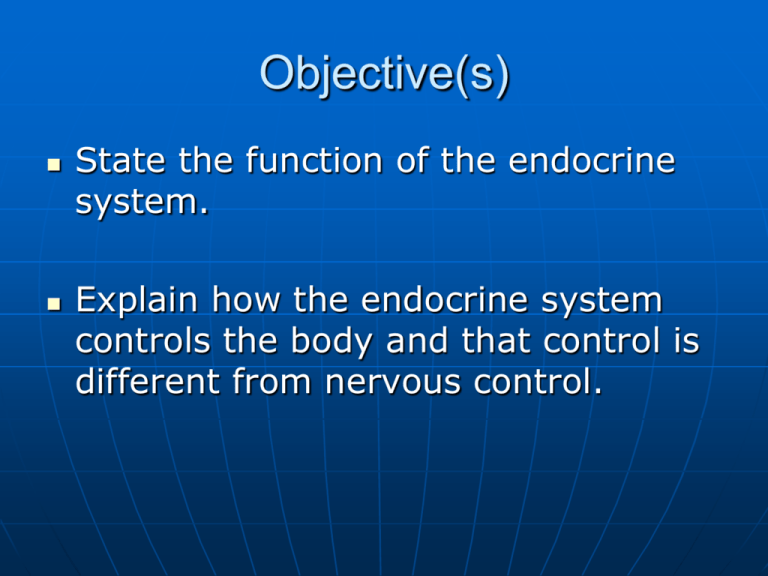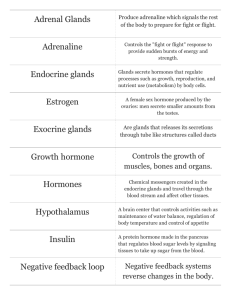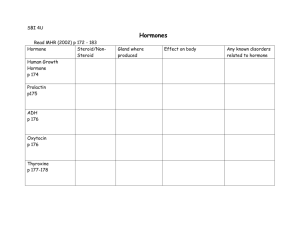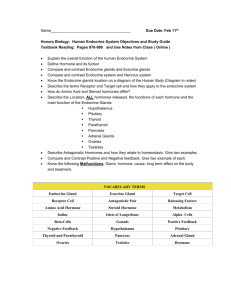Endocrinology - Belle Vernon Area School District
advertisement

Objective(s) State the function of the endocrine system. Explain how the endocrine system controls the body and that control is different from nervous control. Drill 1. What is a hormone? 2. How do hormones work? Drill State how exocrine and endocrine glands are different. How are primary glands different from secondary glands? Objective(s) Describe how a postagladins. List & describe the endocrine glands and list hormones that each produce. Drill 3. Why does a water soluble hormone need a receptor on the cell membrane and a lipid soluble hormone does not? 4. Why does the water soluble hormone need a secondary messenger ? Drill 1. 2. 3. 4. Why is the pituitary considered the “master gland”? What are the two parts of the pituitary gland? What is the mass difference between the two parts? What is the difference in composition between the two parts? Drill What are the effects of Calcitonin on blood calcium levels? What are the effects of parathyroid hormone on blood calcium levels? How do they work together to maintain homeostasis calcium levels? How can Epinephrine from the medulla of the adrenal gland effect the heart so quickly? Drill What cells in the pancreas produces insulin? Which produces glucagon? What is the purpose of insulin? What is the purpose of glucagon? Which type of feedback is used to control blood sugar levels? Endocrinology Endocrine System Primary role is in Works in concert with the in controlling the body activities. - chemical messengers that circulate through out the blood stream. Take longer to reach their destination ( ). Effects are & . Regulate continuing process for that must go over for of time. - are chemical messengers that act only on target cells. • • the blood. -within the same cell. -to other cells. - local effect on the same cell type. - effect other cell types without being transport by & Neurotransmitters-nervous system -secrete into the environment. Release in small Their effect is an (receptors) , but extremely . of target cell Their release is regulated mainly by . Review 1. 2. 3. Define endocrinology. Define a hormone. How are hormones controlled? Composition of the Endocrine System The endocrine system is composed of the numerous glands that secrete their products (hormones) into extra cellular space. - secrete product into ducts & then transported into body cavities or surfaces. - Secrete their products into extra cellular spaces & then diffuse into the blood stream. Review 1. How are endocrine glands different from exocrine glands? 2. Give an example of each form above. Primary glands 1. 2. 3. 4. 5. 6. B. Secondary Glands 1. 2. C. Secondary Function 1. 2. 3. 4. Hormone Action Two types of cellular receptors Hormones act only upon cells to which they selectively bind. The two major classes of hormones induce changes in cellular activities in two different ways. 1. soluble hormones (Membrane bound receptors) pass through the cell Need a secondary messenger: Cyclic AMP (cAMP) (adenosine monophosphate). Hormone ( ) binds to receptor. Receptor is bound to a enzyme ( ). Adenylate cyclase activates the conversion of to (secondary messenger). cAMP diffuses throughout the cell initiating chemical reactions that result in the activation of . Protein kinases act to effect other . Change metabolic activities. Promoting or altering synthesis of proteins. Alter membrane permeability. Stimulate the release of hormones & other cellular products. Epinephrine, norepinephrine, antidiuretic hormone, oxytocin, calcitonin, parathyroid. Review What must hormones bind to, to cause the target cell alter its activity? Why can’t water soluble hormone pass through the cell membrane? 2. hormones (Intercellular chemical signals) Mainly . Dissolve through . Bind to protein receptors within the cytoplasm. Hormone-receptor complex then Binds to a . Turns on the of a of . . . Stimulate/inhibit metabolic activities. Alter rates of other cellular activities. Protein products may act as structural proteins. Aldosterone, cortisol. Testosterone, estrogen, & thyroxin. Review How come lipid soluble hormones pass through the cell membrane and water soluble hormone can not? Where does lipid soluble hormone bind to its receptor? Which one, water or lipid hormones, are faster to cause the cell to alter its activity? 3. “Local hormones” Group of chemical that also have regulating effects on cells. Made of lipids. Lungs, liver, digestive tract, kidneys, pancreas, brain, reproductive organs. Stimulate or inhibit the use of cAMP the effect of hormones that use . Smooth muscle relaxing (opens airways, reduce blood pressure). Inhibits HCL secretion in the stomach. Increases intestinal contractions Stimulate uterus contraction. Causes inflammation. Sleep inducing & antineoplastic activities. Hormonal Control The control of hormone secretion rates is provided by chemical signs that relay information about the output levels & in some cases, by nervous control. (blood level chemistry, hormone, nervous system) 1. Feedback Control A. - controls the level of hormones by providing a response in the opposite direction to that stimulus. B. Controls secretion by providing a response in the same direction of the stimulus. Cause extreme changes in conditions in the body. Oxytocin - stimulate uterine contractions Review 1. Define a Prostaglandins. 2. How are hormones controlled? 3. What is the difference between a lipid and water soluble (protein) hormone in chemical composition? The Endocrine Glands Are hormone secreting organs that are widely distributed. 1. Pituitary Gland ( ) a. Tiny pituitary gland produces many hormones, some of which control the activities of other glands. b. Both of its lobes receive their from the . c. Located at the base . d. g (0.02 ounces) e. Attaches to the hypothalamus by a narrow stalk - A. -Glandular part ( ) -75% of its entire mass -5 different types of secretory cells that release 7 types of hormones 1. Stimulate bone cells to grow & divide. increase the rate of carbohydrate & Lipids are catabolize. Maintain a constant blood sugar level. 2. Stimulate & maintains milk secretion by the mammary glands. 3. Controls the thyroid gland 4. (adrenocorticotropic hormone) - tropic Controls hormones release by the outer region of the adrenal gland. 5. (melanocyte stimulating hormone)- tropic Stimulates the production of melanin 6. - tropic Females - stimulates the development of the egg - stimulate the ovaries to secrete estrogen Males - Stimulate the production of sperm 7. - tropic Females - Release of the ovum - prepares the uterus for implantation of the fetus Males - Stimulate cells to produce & secrete testosterone B. -Actually an extension of the hypothalamus -Mainly that support terminal ends of axons -Neurosecretory cells -Stores products produce by the hypothalamus until its time to release them. 1. OT -Stimulate the contraction of smooth muscle. -Stimulate the cells around mammary gland to contract. -Begin uterine contraction 2. Antidiuretic Hormone -Helps the body to conserve water. -Helps to regulate blood pressure by stimulating the contraction of smooth muscles - Vasoconstriction. Pituitary Gland Review Why is the pituitary gland considered the master gland? What is the differences between the anterior & posterior lobes? 2. Thyroid Gland -Regulate , & reduce calcium & phosphate levels in the bloodstream. -Glandular epithelium tissue. -Lobes are connected by an isthmus. A. Thyroxin (t4) & Triiodothronine -Promote protein synthesis -Increase the rate of glucose uptake -Promote lipid metabolism -Accelerate actions of the nervous system B. Calcitonin -Reduce calcium & phosphate levels in the blood. -Stimulate osteocytes activities -Stimulate the secretion of calcium by the kidneys. Thyroid Gland 3.Parathyroid -Behind the thyroid. - levels in the blood. A. Parathyroid hormone (PTH) -Maintaining the calcium & phosphate levels in the blood. -Opposite effect to calcitonin. -Stimulate osteocytes to break down bone. -Re-absorption of calcium by the kidneys. -Activates Vitamin D - increase the amount of calcium absorbed from digestion. Parathyroid Review 1. Where is the thyroid & parathyroid glands located at? 2. How do these two glands work together to maintain homeostasis? 4. Adrenal Glands -Two portions -Hormones released by the inner medulla performs similar functions of the sympathetic nervous system secretions performs many roles including the regulation of fluid balance, glycogen synthesis, & sex characteristics. -A pair of triangular masses that lie on top of each kidney A. Medulla -Composed of . -Cells originate from the that change during late embryonic stages. -Remain connect to the of the sympathetic nervous system. -Epinephrine & Norepinephrine. - changes in the body that mimic those produces by the sympathetic nervous system. -Rise in metabolic rate, increased alertness, enlargement of airways emergency situations. B. Cortex -Composed of . -Aldosterone - steroid hormone that maintain fluid balance. -Cortisol - promote glucose & glycogen synthesis in liver cells. -Androgens - masculinizing effects. -Estrogen - feminizing effects. Review 1. Where are the adrenal glands located? 2. What are the two parts of the adrenal glands? 3. What is the inner portion composed of to make the effects of Epinephrine so effective? 5. Pancreas of the pancreas produce that have opposing effects. -Together they help to maintain proper glucose levels in the blood. -Two body system 1.) Digestion 2.) Endocrine. -Two types of cells 1.)alpha cells 2.) Beta cells. - - stimulate the conversion of glycogen into glucose. - stimulate the formation of glycogen from glucose. Diabetes Mellitus -10 million suffer in the US -May be life threatening Type I - juvenile -decreased in beta cells -lower levels of insulin -Controlled by daily injections. Type II -Develops gradually -Most common in overweight persons over 40. -Target cells can no take up insulin. -Hyperglycemia - high levels of glucose -Acidosis - low ph -Dehydration -Diet & weight control -Insulin injection in the most sever cases. 6. - sex organs Ovaries Estrogen Progesterone Testes Testosterone 7. 8. Melatonin - inhibit FSH & LH Thymosin stimulate the production of certain white blood cells (T-lymphocytes). Review What are the two hormones produced by the pancreas that regulates blood sugar levels? How do the above hormones work to maintain homeostasis? Problems with the Endocrine System Homeostasis - high level of hormones – under active glands Problems 1. – Loss of too much sodium- Dehydration 2. – Excessive reabsorption of sodium. Large amounts of water. 3. – Cessation of the menstrual cycle due to hypersecretion of prolaction. 4. Deficiency of the thyroid hormones Decreases the metabolic rate. Reduces growth & development. 5. – Protrusion of the eyes to hyperthyroidism. 6. Cushing Syndrome – Excessive production of cortisol Excessive fat accumulation in neck, face, trunk. 7. Graves disease – Excessive production of thyroid hormones. Hyperthyroidism. Increased metabolic rate, weight loss, nervous, hypertension. 8. – Enlargement of the thyroid gland. 9. – hyperthroidism in adults. Thicken skin- puffy appearance in face and hands. Lack of energy. Slow nervous reflexes.









